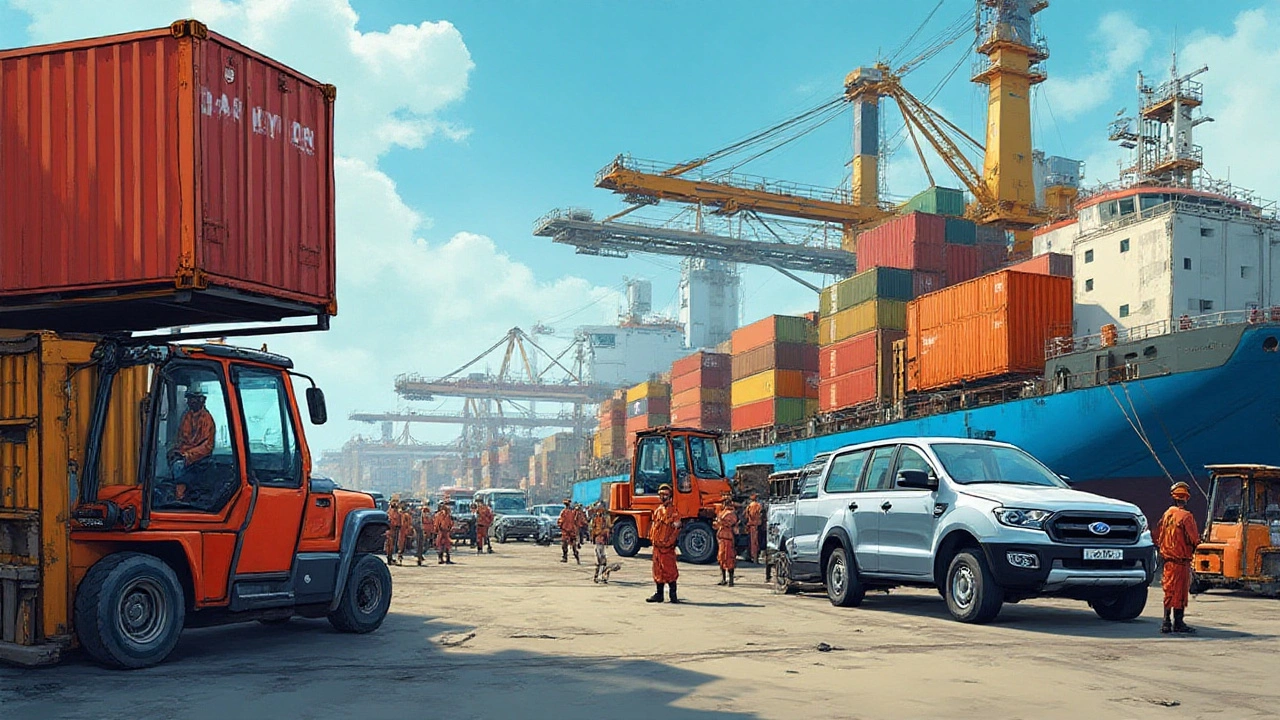
Bentleys zoom past, Lamborghinis snatch every smartphone camera on the street, and some people swear by their trusty Subarus. Yet, try finding any “Made in India” stamp on these luxury rides, or even some mainstream favorites, and you'll be out of luck. Ever wondered why certain car brands and models just don’t roll off Indian assembly lines, even after years of market boom and demand? There are wild stories, economic showdowns, and strategic hiccups hiding behind the absence of these cars in Indian factories. This list might even change what you think about those glossy rides at fancy showrooms or the ones you see starring in movie chases.
Luxury Cars and Supercars That Dodge Indian Assembly Lines
If you've got a soft spot for luxury, let's talk numbers first. India’s luxury car market, though growing fast, still only makes up about 1% of the country’s total car sales. Compare that with Germany or the US, and you see the gap. This limited demand is the main reason you won’t find brands like Bentley, Lamborghini, Ferrari, Rolls-Royce, Aston Martin, McLaren, Maserati, or Bugatti with "Made in India" stickers. Their parent companies prefer to ship in completely built units (CBUs) because it simply isn’t worth building local plants for just a handful of cars each year.
Making a car in India isn’t just about sticking some parts together. Building a manufacturing line for a specific model runs into millions, even billions, of dollars. Now, imagine selling just 50 to 100 units a year—a figure Bentley and Rolls-Royce typically move in India. India’s import law stacks a 100% duty on CBU imports, so the price tag doubles, but deep-pocketed buyers don’t seem to mind. Ironically, this import duty is also one of the reasons local manufacturing lags behind: luxury brands figure that those who can afford their cars will pay the premium.
Some brands did flirt with the idea of Indian assembly. Mercedes-Benz, BMW, Audi, and Volvo do assemble several models at their Indian plants, which helps dodge the full brunt of import taxes. However, their flagships—think BMW M8, Mercedes-AMG GT, or Audi R8—still sail in as CBUs because the niche is ultra-tiny. Ultra-premium SUVs like Lamborghini Urus or Rolls-Royce Cullinan also land fully built from Europe, as the volumes are way too low to justify assembly or local parts sourcing.
Here’s a quick look at some luxury brands and their Indian manufacturing status:
| Brand / Model | Manufactured in India? | How Sold in India |
|---|---|---|
| Bentley | No | Fuel-imported CBUs |
| Rolls-Royce | No | Imported CBUs |
| Lamborghini | No | Imported CBUs |
| Ferrari | No | Imported CBUs |
| Maserati | No | Imported CBUs |
| Bugatti | No | Imported CBUs |
| McLaren | No | Imported CBUs |
Interesting fact? The process of importing also means models arrive with specs often tailored for Europe or the Middle East, so local buyers might sometimes miss out on features or have to adjust to Indian driving conditions with quirky workarounds. Luxury car enthusiasts in India often face longer waiting periods since only a few units are allotted for Indian allocation every year, and customization options can extend delivery timelines even further.
Is there hope for locally built supercars? Never say never—Indian brands like Vazirani Automotive and mean machines like the DC Avanti have tried to break in, but they’re nowhere near Ferrari or Lamborghini territory. And for now, the demand just isn’t big enough to move the needle for global giants.

Popular International Mainstream Cars Missing Indian Manufacturing
It's not just Lamborghinis that stay away from Indian assembly. Some practical, everyday brands loved worldwide don't set up shop locally. The reason isn’t always about luxury or price—think brand strategy, government policy, or just plain old market mismatch. You’d probably expect to see brands like Subaru, Peugeot, Citroën (until recently), Renault (for its global models other than Kwid, Triber, and Kiger), SEAT, and Skoda’s more niche variants rolling out of Indian plants. But nope, they haven’t committed to Indian assembly for many of their models.
Want a Subaru Forester or Outback? You’re out of luck—they’re basically unicorns on Indian roads unless you jump through import hoops. Subaru just doesn’t have a factory in India, citing the massive investment needed and high market fragmentation as turnoffs. Peugeot did sell cars in India briefly two decades ago but pulled out due to poor sales, and though PSA made a comeback with Citroën, they’ve only started assembling a handful of models locally since 2021. Many other Citroën models are still imported.
Even within brands that manufacture in India, some of their most popular international models are missing. Toyota, for example, assembles the Innova and Fortuner locally, but the Land Cruiser, Hilux (until recently), and the Prado are usually sold as imports, and only in limited numbers. Volkswagen’s Polo and Vento have seen local production, but global models like Arteon or Passat GTE don’t get assembled here. Honda’s Indian lineup features the City and Amaze, but dream about an Accord Hybrid or a Civic Type R, and you’ll be left wanting—they’re simply not on the production radar due to price or demand.
Why this cherry-picking? Automakers look for volume, stable regulations, and an established supply chain before betting big on local production. India’s car market is fiercely price-sensitive, so high-end models or imported tech-laden cars rarely see enough mass interest. Also, emission norms (like the jump to BS6) and unique safety standards mean brands must heavily tweak international models—again, not worth it unless volumes justify the cost. Many brands, instead, focus on developing India-specific models to compete in the budget and compact segment, often skipping their global flagships.
Here’s a quick glance at popular international mainstream cars not made in India:
| Model/Brand | Not Manufactured In India |
|---|---|
| Subaru (All Models) | Yes |
| Peugeot (Most Models) | Yes |
| Volkswagen (Arteon, Passat GTE) | Yes |
| Toyota Land Cruiser, Prado | Yes |
| Honda Accord Hybrid, Civic Type R | Yes |
Another big chunk missing? Pick-up trucks. Globally, Ford’s F-series or Chevrolet Silverado are best-sellers in the US, but they never saw the light of day at Indian factories because the pick-up truck culture, road conditions, and tax policies just don’t support them yet. Same story for the legendary Jeep Wrangler and Ford Mustang (all imported as CBUs until recently; Mustang is now discontinued for India).
For people wanting these cars, the route is usually special imports, known as CBU imports, and that means paying hefty taxes and waiting months for delivery. Sometimes, you’ll even hear about private players importing very limited numbers for passionate enthusiasts or the ‘gray market’—though warranties and after-sales support can be a nightmare.

The Business Logic: Why Some Cars Are Never Manufactured in India
At first glance, you’d think India would be a dream for carmakers. Think of a billion people, rising incomes, and endless need for mobility. But several hard realities shape why these global brands skip setting up local factories for some or all of their models. First off, the Indian car market is fiercely competitive but mostly in the affordable, sub-₹10 lakh segment. Anything above that fights for a tiny slice of the pie. The golden rule for most foreign auto giants is this: If you can’t sell at least 10,000 units of a model a year, investing in a manufacturing plant is a bad business call.
It’s not just about economics, though. India’s regulatory landscape—a maze of emission rules, homologation, crash test norms, and part localization targets—makes local manufacturing an expensive, time-consuming puzzle. For example, when India shifted from BS4 to much stricter BS6 emissions in 2020, automakers had to redesign their engines, which put off a chunk of high-performance and diesel cars from Indian assembly lines.
Then there’s supply chain complexity. Car companies need a robust local ecosystem of part suppliers, skilled workers, and logistics. Many luxury and niche cars need specialized components—like a Ferrari V8 engine or advanced driver aids—that suppliers in India might simply not make or make economically yet. Moving the whole supply chain just for a handful of cars is like building a stadium to host one cricket match.
The other factor? Local tastes. Indian car buyers often want robust suspension for rough roads, high ground clearance, good air-conditioning, and affordable service. The features that thrill people in Europe or North America—massive engines, AWD, high-tech infotainment—don’t always find takers here at scale. So, unless a brand wants to totally re-engineer their cars for Indian tastes, importing remains much simpler.
Geopolitics also plays a role. With recent shifts in foreign investment rules and economic tensions, several foreign carmakers hit pause or scaled down their Indian roadmap. Examples? General Motors exited the market in 2017, FIAT dropped out, Ford shut down local production in 2021, and many others scaled down to focus on exports or a few select models only. Some Chinese brands like GWM and Chery have delayed their India entry due to regulatory and political uncertainties, meaning their global models stay off Indian assembly lines for now.
Now for a quick tip: if you are itching to own a car model that's not manufactured locally, check if the brand officially imports it as a CBU or allows customization for Indian conditions. Make sure you ask about parts availability, warranty coverage, and after-sales service—things can go sideways if your imported ride needs a part that takes weeks to source from overseas. Also, remember, resale value tends to drop for imported niche cars compared to mass-produced, made-in-India models due to costlier repairs or a limited buyer pool.
On the flip side, here’s an interesting stat: since 2014, India exported over 6 million cars—especially compact and subcompact models—to more than 100 countries as Indian factories emerged as key global sourcing hubs. So while you may not see luxury Bentleys being made in India, Indian-made cars zip around in Mexico, South Africa, and Latin America. Isn't that a surprise?
To wrap up, the simple reason certain cars not manufactured in India stay that way comes down to business math, unique Indian driving conditions, regulatory obstacles, and supply chain quirks. Keeping a tab on which brands may soon localize production or which new players are entering could help you snag the latest global model at a better price, someday. Until then, keep an eye on those imports—they’ll always have a hint of exclusivity on Indian roads.